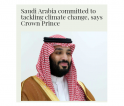Climate change & its impacts, rippling out across all our futures, 1
[ by Charles Cameron — part 1 of this two-part post deals with the impact of climate change on pilgrimages, and on the Hajj in particular ]
.

The Hajj, Mecca
**
Since I posted my poem Mourning the lost Kaaba here in late November 2017 — though not, I imagine, because of my poem — a report on the likely impact of climate change on the annual Hajj pilgrimage has come out from scientists at MIT and Loyola Marymount:
Here’s the abstract:
The Muslim pilgrimage or Hajj, which is one of the five pillars of Muslim faith, takes place outdoors in and surrounding Mecca in the Saudi Arabian desert. The U.S. National Weather Service defines an extreme danger heat stress threshold which is approximately equivalent to a wet?bulb temperature of about 29.1 °C—a combined measure of temperature and humidity. Here, based on results of simulations using an ensemble of coupled atmosphere/ocean global climate models, we project that future climate change with and without mitigation will elevate heat stress to levels that exceed this extreme danger threshold through 2020 and during the periods of 2047 to 2052 and 2079 to 2086, with increasing frequency and intensity as the century progresses. If climate change proceeds on the current trajectory or even on a trajectory with considerable mitigation, aggressive adaptation measures will be required during years of high heat stress risk.
That’s the science — and while Saudi Crown Prince Mohammed bin Salman..

… told the G20 in June that the Saudis are committed to “reducing greenhouse gas emissions and adapting to the negative effects of climate change,” beliefs concerning the Prophet’s institution of the Hajj in 632 CE following on earlier Abrahamic practice may well clash with scientific claims that the Hajj may become impossible for future devout Muslims to observe.
What happens, then, when this divine command intersects with increasing temperatures that eventually render Mecca uninhabitable? How do the climate change scientists fare when they sit across the table from the ulema, the scholar-clergy of Islam?
From a Muslim point of view, we’d better climate-correct, and do so fast:
**
Other readings:
**
The issue I’ve raised above is tightly focused on one sanctuary, one religion, one pilgrimage. Below are some other major pilgrimage sites to consider in light of climate change:
I would be interested in the cross-disciplinary exploration of the impact of climate change as understood by the scientific consensus, global migration patterns now and as expected in the coming years, and the devotional rituals and ceremonials of the various religions involved.
Large pilgrimages and religious ceremonials
This list draws text from Wikipedia and other online information sites.
Kumbh Mela:
Allahabad, India, 120 million devotees, every 12 years. The Prayag Kumbh Mela is a mela held every 12 years at Allahabad, India. The fair involves ritual bathing at Triveni Sangam, the meeting points of three rivers: the Ganga, the Yamuna and the mythical Sarasvati. The Kumbh Mela in 2013 became the largest religious gathering in the world with almost 120 million visitors.
Arba’een:
Page 1 of 2 | Next page